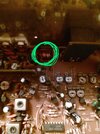Hello,
I am sorry I have not been back for some time. I have been probing around on the Saturn and had discover TR42 was actually opened. Its a 2sc945.
I removed the bad one and popped in a new one and just like that the audio was back up and running loud.
The strange thing that puzzles me, until I look into it some more, it looks like that transistor should be for the receive audio.
Maybe someone who knows this radio better than I of course can shine some light on this area.
Also I found D83 cut for some reason. I wonder if this has something to do with by passing vr14 the modulation control on the board, because I have no control of VR14.
I have also found D68 cut and TR32 cut. TR32 is another 945 transistor. I had replaced these parts after fixing the audio issue, so I have no idea what these components do. I need to look back onto the schematic and try to follow the circuits I guess.
I am still looking into refreshing this radio where I can find where it is needed. Again I am sorry I have not returned until now. I am always out and about helping where I am able and sometimes I do not have time for myself.
I surly appreciate everyone here for their knowledge and their willingness to share their knowledge.
I wanted to at lease place this info on this particular post in case anyone else may run into this same situation. It was a strange one for me thats for sure.
RF Krazy
I am sorry I have not been back for some time. I have been probing around on the Saturn and had discover TR42 was actually opened. Its a 2sc945.
I removed the bad one and popped in a new one and just like that the audio was back up and running loud.
The strange thing that puzzles me, until I look into it some more, it looks like that transistor should be for the receive audio.
Maybe someone who knows this radio better than I of course can shine some light on this area.
Also I found D83 cut for some reason. I wonder if this has something to do with by passing vr14 the modulation control on the board, because I have no control of VR14.
I have also found D68 cut and TR32 cut. TR32 is another 945 transistor. I had replaced these parts after fixing the audio issue, so I have no idea what these components do. I need to look back onto the schematic and try to follow the circuits I guess.
I am still looking into refreshing this radio where I can find where it is needed. Again I am sorry I have not returned until now. I am always out and about helping where I am able and sometimes I do not have time for myself.
I surly appreciate everyone here for their knowledge and their willingness to share their knowledge.
I wanted to at lease place this info on this particular post in case anyone else may run into this same situation. It was a strange one for me thats for sure.
RF Krazy


